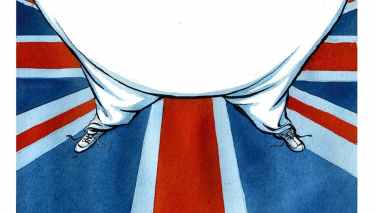
Bankers are often accused of having such short memories that they are condemned to repeat the errors of their immediate predecessors, only more so. They would certainly need elephantine memories to remember a time when new banks, each with a distinctive mission and marketplace, were coming to life and flourishing everywhere. Indeed it was, in a corporate sense, Britain’s oldest banker — Alexander Hoare, 11th-generation head of C. Hoare & Co of Fleet Street, though himself still only in his forties — who pointed this out to me long before the credit crunch started knocking over high-street lenders like wonky dominoes. ‘It’s a sign of market failure that so many consumers are dissatisfied with their existing banks yet there are so few green shoots, so few new banks springing up as Hoare’s and many others did,’ he told me in an interview for The Spectator in October 2004.
He was recalling the 1670s, when his ancestor Sir Richard Hoare first opened for business at the sign of the Golden Bottle, a couple of decades ahead of the Bank of Scotland in Edinburgh and the ancestors of Barclays in Lombard Street. Throughout the 18th century, small-town banking partnerships grew up — and mostly prospered — aligned to the needs of local trade, agriculture and nascent industry. In 1775, the building society movement was born in Birmingham; by the mid-19th century, as people flocked to cities and towns for factory work, there were 1,500 of them. Among those whose owners or successors have recently had to be rescued by the taxpayer, the Cheltenham & Gloucester, currently subsumed into Lloyds, dates from 1850, as does the Northern half of Northern Rock. The Bradford Equitable and its neighbour the Bingley opened for business a year later, shortly followed by the Halifax Permanent, which became the H in HBOS. Each served their community admirably but cautiously, and without much in the way of competitive edge, until they were overwhelmed by the modern maelstrom of merger, demutualisation, global ambition and bonus mania.
But now, largely thanks to terms dictated by EU competition commissioner Neelie Kroes as the price for permitting massive state aid for our crippled banks, the pendulum of banking history is beginning to swing the other way. Some old names, including Cheltenham & Gloucester, are about to reappear, alongside some entirely new ones — and much comment and ministerial spin on the subject has been about what a good thing this is from the point of view of competition and choice. Yet it was an excess of competition that drove lenders, crowded side by side in every high street, to offer the imprudent, too-easy mortgage deals, particularly in the buy-to-let sector, that fuelled the boom and bust. If we’re going to have another retail banking revolution, we don’t want it merely to replicate, under different brand names, the follies of the last one. What we do want, I suggest, is localism, specialism and a whole new definition of customer service.
‘TSB Scotland’ may not sound exciting as a brand revival, for example, but by spinning off its north-of-the-border branches under that banner, Lloyds has the opportunity to revive a local savings bank movement begun in 1810 by the Revd Henry Duncan of Ruthwell, Dumfriesshire to help poor parishioners put pennies aside for hard times; that would surely count as a ‘socially useful’ financial service, even under Lord Turner’s definition. And Royal Bank of Scotland has announced that it will resurrect and sell off Williams & Glyn’s, a brand it extinguished in the mid-1980s. ‘Williams’ was Williams Deacon’s Bank in Manchester and industrial Lancashire. ‘Glyn’s’ refers to Glyn, Mills & Co, a City firm which financed 19th-century railways, nurtured strong, long-term corporate relationships, and was famous for the quality of its management ‘cadets’ — a few of whom, including Sir Jeremy Morse, are still with us today. Why not separate them again, creating a pair of banks that really know their territory and client base, rather than an RBS clone whose branch distribution is a mere accident of history?
What a pity, indeed, that Mrs Kroes did not insist that RBS should sell off another well-respected name in its portfolio: Coutts & Co, the Queen’s bankers in the Strand. Clients of the ‘private banking’ arms of all large financial conglomerates suffer the risk of being stuffed with products designed to make fat commissions for the bonus-hungry whizz-kids in the group’s capital markets divisions, rather than to respond to the individual needs of the customer. Wealth management is better conducted by smaller firms for whom success is based wholly on client satisfaction, not on meeting sales targets from head office.
And there are a host of other reasons why smaller banks are more appropriate to the globalised, high-technology age than ‘universal’ ones. For a start, no one can now argue that a giant bank, exposed to every real-estate, commodity and money market around the world, is better protected against a crash than one which only lends on houses within a 50-mile radius of Halifax. What really matters, we now know, is whether the bankers understand in detail the risks they are taking. And that is more likely to be the case in those with a narrower focus of geography and product. What’s more, if those smaller banks are at least partially owned by the people who manage them, they will be far more cautious and less hypnotised by executive bonus prospects than the giants proved to be.
Likewise, economies of scale no longer apply if every technical function — credit card and internet services, ATMs, payroll and pension administration — can readily be outsourced: a medium-sized bank could be run on a network of cheap laptops these days. In a better banking world, ‘wholesale banks’ would become just that, providing arms-length products, services and funding to retail banks who genuinely serve customers, including smaller businesses.
The multiple-choice consumerism prevalent today means that in all kinds of businesses, however technologically driven, success will increasingly come through personalisation. Some customers demand green-tinged ‘ethical’ banking. Some still want a nice old-fashioned face-to-face bank manager. Some prefer a 24-hour telephone and online service of the kind pioneered by the likes of First Direct, while others no doubt would happily do their banking through Facebook. Those who just want to bank where they shop will be early adopters of the in-store Tesco Bank, coming shortly. And those who want something wackier may be attracted by a venture called Metro Bank, which has plans for 200 branches under the unlikely slogan ‘Love Your Bank’. Perhaps loyal readers would welcome the launch of Spectator Bank: I’m picturing a branch format that combines the feel of antiquarian bookshop, internet café and, of course, 18th-century coffee house.
As for all the old banks whose local knowledge, customer affinity and participation in community life got lost when they were swallowed by empire-building conglomerates, there are hundreds waiting to be liberated. The only brand I wouldn’t bother trying to resuscitate — out of the NatWest wing of RBS — is ‘Westminster’. Who’d trust a bank with a name like that?






Comments